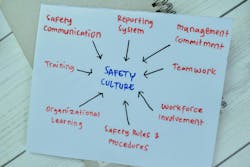SLC 2024 Preview: The Magic Formula for Safety Culture Training
When companies roll out global corporate initiatives, they can sometimes face pushback at the local level.
This could be because of a difference in programs and processes, how a facility or team operates, or a variety of other factors. But usually, it boils down to the fact that people don’t like having a culture imposed or mandated upon them.
That’s what makes Baxter’s safety culture training program so unique—and so successful.
Kristen Heitman, MSc, senior manager of EHS&S training and development, will share how Baxter’s revitalized safety culture program is helping the company reach more employees and make the workplace safer.
Heitman will speak at the 2024 Safety Leadership Conference that’s taking place Aug. 26-28 in the greater Denver area. More information, including registration, can be found here. Below is a preview of what to expect from Heitman’s presentation.
EHS Today: Can you tell me more about Baxter's Start When Certain program? What is it focused on?
Heitman: Start When Certain (SWC) is Baxter’s safety culture movement. Initially launched as a stop work authority program, it has evolved into a safety culture training program that focuses on culture and how our safety DNA impacts our behaviors through safety critical conversations, safety gembas, recognition, hazard identification and reporting.
This message cascades down to frontline employees through monthly SWC messages and discussions on these leading indicators of safety. The training program balances knowledge transfer, practical application and engagement activities. SWC will continuously improve, with sites delivering new training sessions, programs and experiences that support safety culture growth.
Why did Baxter start this program, and what were the goals for this program? When did you launch the program?
Baxter had historic iterations of safety culture programs, and SWC was initiated in 2022 as a revitalization. It became obvious through incident analysis and leadership feedback that tackling our toughest safety challenges was going to require strategically addressing our safety culture. SWC was developed to address Baxter’s highest hazard and frequency safety risks through the lens of leading indicators and safety.
The goal of the training program was to integrate key safety topics into a cohesive and effective program scalable to local needs and aligned to a global direction. We knew we had to build a program that blended technical skills and applications with the interpersonal and intrapersonal connection to safety that really drives change.
Last year, we visited six international sites, training 150 people leaders and surveying 650 frontline employees in a Powered Industrial Truck (PIT) focused mission. This year, we have 50 SWC trainers in scope and 30 sites identified for deployment.
What achievement are you most proud of?
I am proudest of the fact that we are building accountability and ownership into the program at all levels of the organization. A lot of EHS programs get formulated from the top down. SWC opens up 360-degree communication using our already embedded organizational systems and processes to discuss leading indicators of safety, from the leadership level to frontline employees.
Sometimes EHS messaging can be a one-way street. As leaders, we are always giving direction and providing feedback, which can sometimes make it seem like safety is just our job. By intentionally inviting others to participate and lead the conversation on safety, our biggest population of experts has a chance to expedite culture growth and change.
Your program is focused on leading indicators. How are you monitoring, measuring and quantifying those?
SWC focuses on hazard identification, safety gembas and safety recognition. Baxter already has very successful systems for tracking other areas of performance, so we tapped into those. Most of our locations already monitor leading indicators of safety, so it was mainly a matter of adjusting or adding an additional component. If there is a gap, we rely on best practices from other sites. Hazard ID rates, safety gemba completions and employee recognition are then systematically reviewed as a part of the larger process.
From a global level, we measure success as adoption of our training objectives through a post-training survey, track hazard ID reporting trends across SWC sites and assess outputs against our safety climate scores as we plan for improvements.
Why was it important for Baxter to create a global program that could be adjusted locally?
We knew that to succeed in establishing a global vision for safety culture, we had to provide a lot of different pathways to get there. Because Baxter is a broad, distributed organization, there are many unique features and strengths among our sites. By anchoring our vision to a few guiding principles, we have been able to work with each site to customize the training program to meet them where they’re at, which has helped develop a sense of ownership and partnership.
It's easy to sell training to new employees, as they need to learn standard operating procedures for the industry and the employer. It can be tougher to engage experienced employees who know the ropes (or think they know the ropes). How did you approach training for all levels of employees?
Make it interactive and personal! Safety may not be new, but we can certainly come up with new ways of introducing these topics to learners. Make it fun by including games, interactions and practice sessions that reinforce the learning objectives. Build in experiences that allow the learners to connect personally with the material—and give them the chance to develop their own ‘why’ behind the desired outcome. Find innovative ways to look at safety with a new light.
Why did you focus on tactile safety skills in both technical and professional applications? Can you give some examples of what that looks like?
We planned this training with a holistic viewpoint. It needed to deliver knowledge around technical topics while also developing personal skills and competencies to support safety. For example, with our focus on safety gembas we train learners on how to use the electronic gemba system as well as how to approach safety critical conversations that may emerge. It can’t just be one or the other.
It takes a lot of personal and emotional skills to navigate the workplace. On the other hand, technology is also rapidly evolving and can be hard to keep up with. Training needs to be the opportunity to tie all the pieces together and set up our learners for success.
How is Baxter incorporating data, such as safety DNA profiles and safety climate scores, as part of its larger efforts or operations?
Baxter is using safety climate data to inform our safety strategies and programs as we grow and evolve. We have a lot of safety metrics around events and incidents that are already incorporated into planning. Safety climate data provides another perspective on our strengths and opportunities as an organization. It can be used as a road map, both locally and globally, to drive decision-making around safety initiatives and programs.
What is something safety professionals can start doing today to improve their safety culture?
There is so much you can do! The secret is to have a well-thought-out idea and a reliable process for making it happen consistently. Some of my favorite small actions are:
- bring leadership and different levels of employees into incident and near-miss reviews;
- start an EHS tip of the week and assign volunteers to lead a discussion;
- partner with employees and supervisors to review risk assessments;
- start a peer-to-peer safety recognition program that involves doing the right thing;
- ask for feedback on safety changes and projects from effected employees;
- host a wellness event, such as an exercise challenge; and
- nominate safety champions to partner with new employees for safety onboarding.
What's one thing you hope attendees take away from your session at the Safety Leadership Conference?
Safety culture training doesn’t need to be complicated. You can build a program that is unique to your organization and drives safety performance by following a straightforward formula and plan.
About the Author
Nicole Stempak
Nicole Stempak is managing editor of EHS Today and conference content manager of the Safety Leadership Conference.


